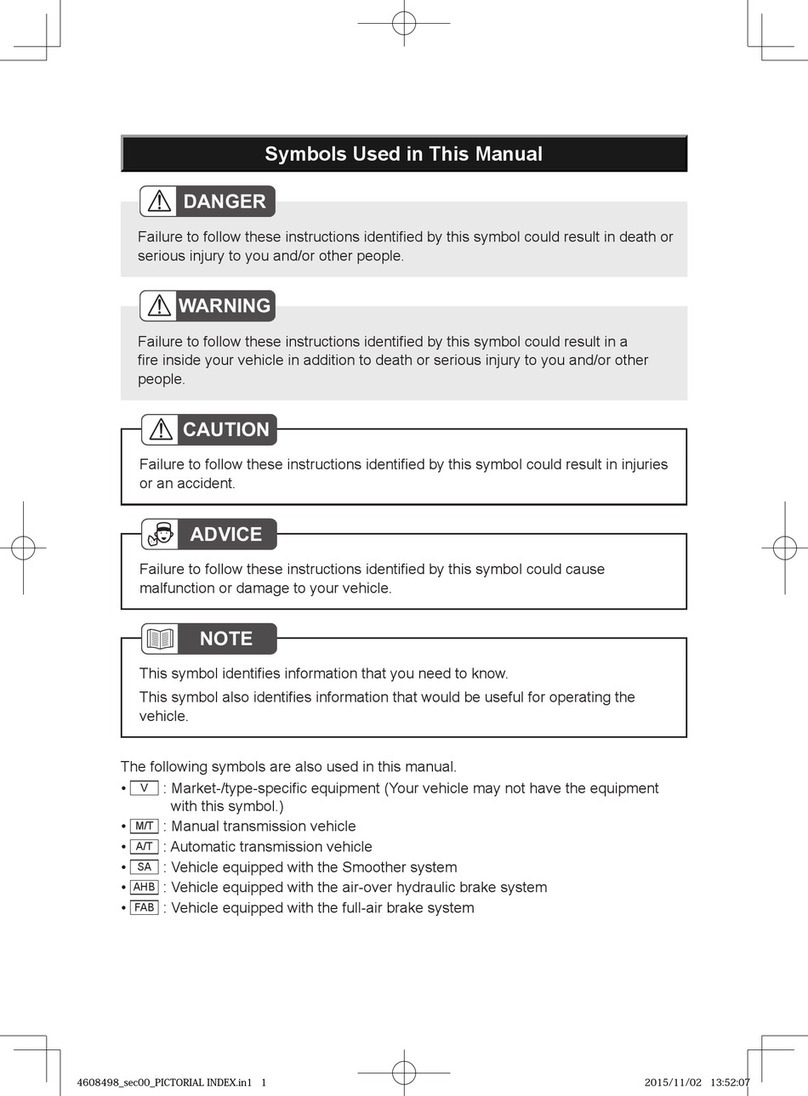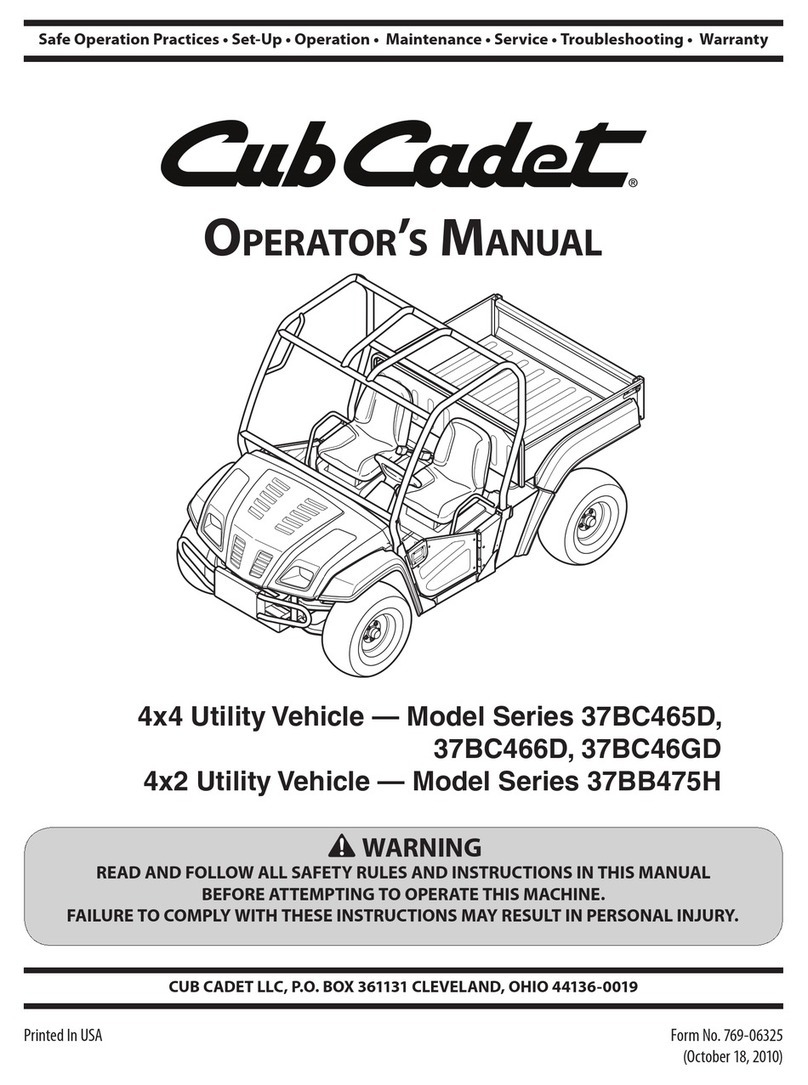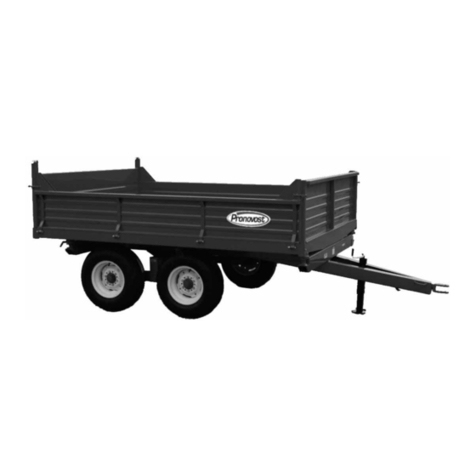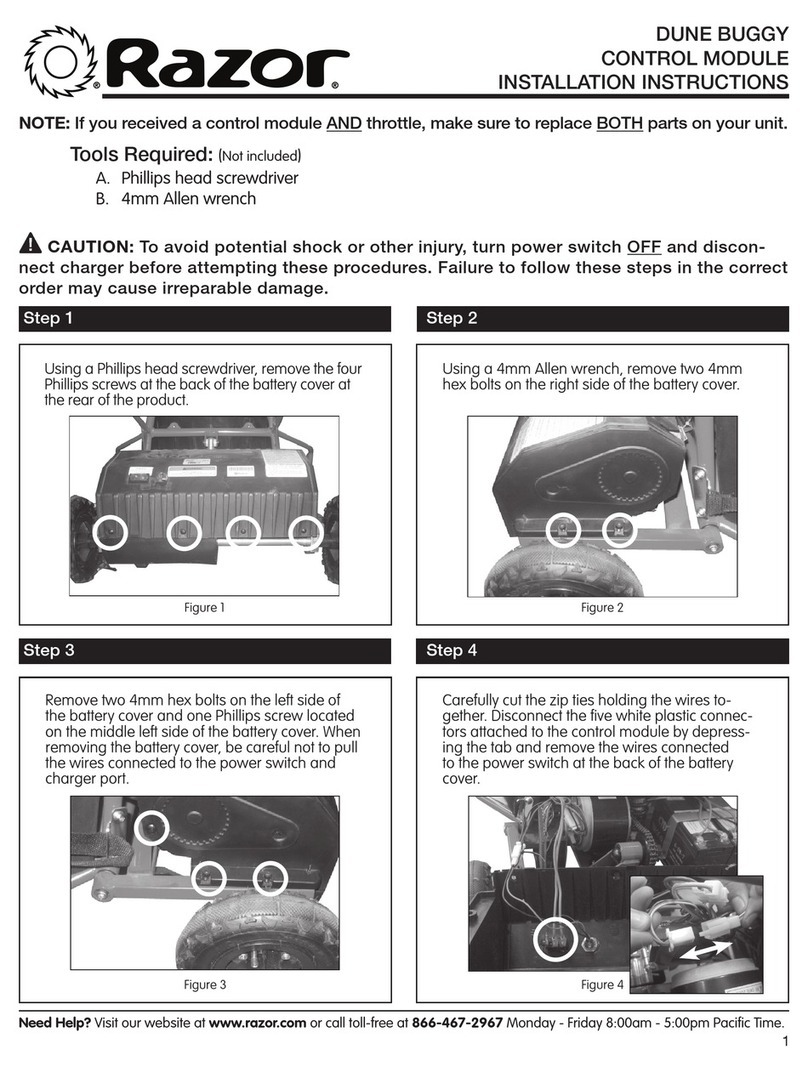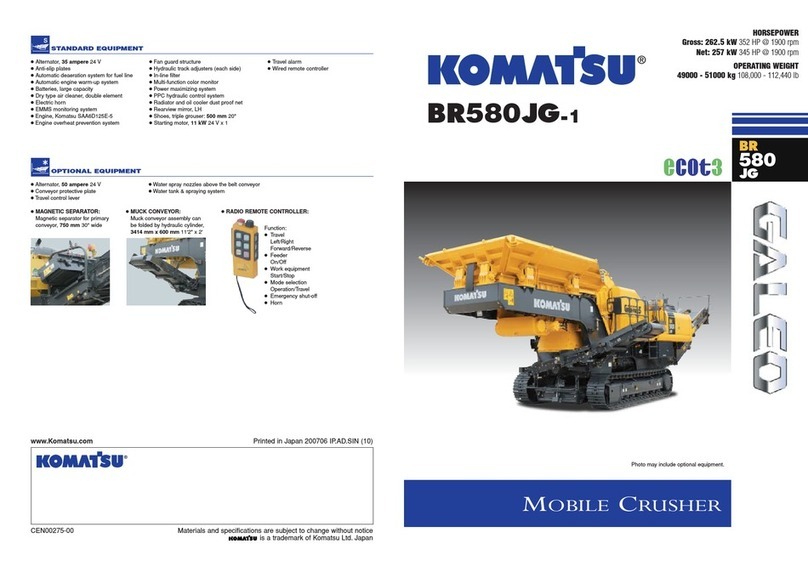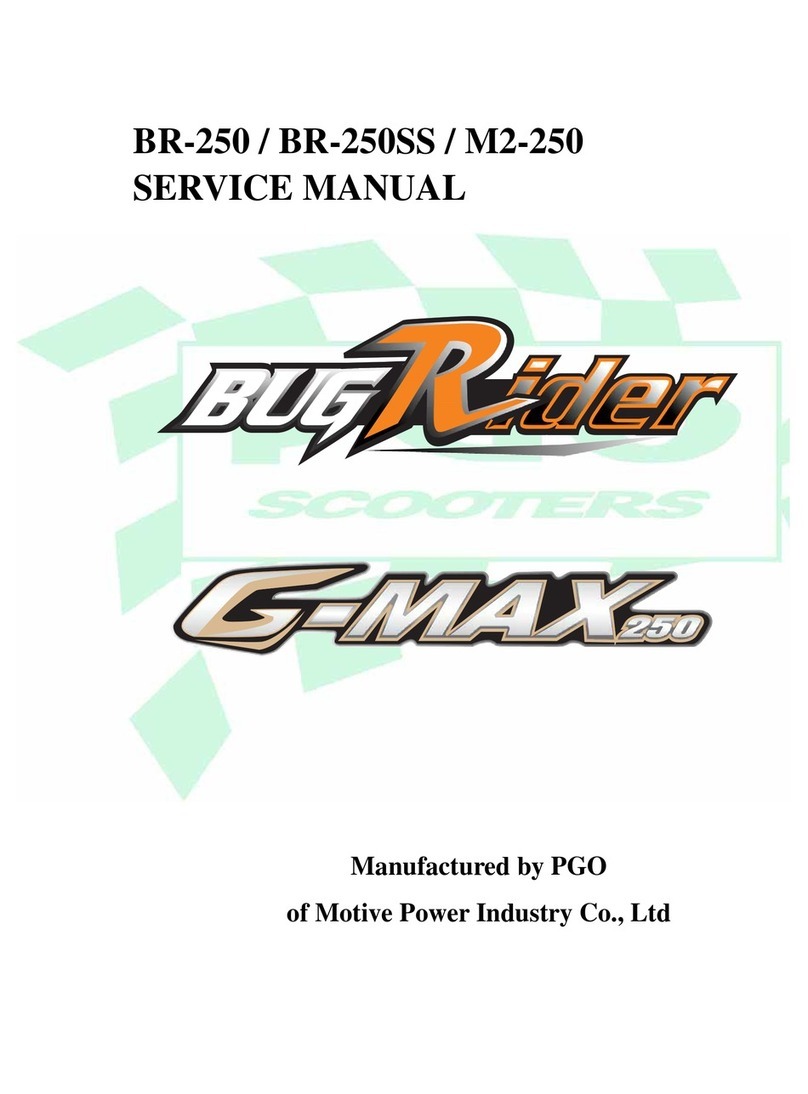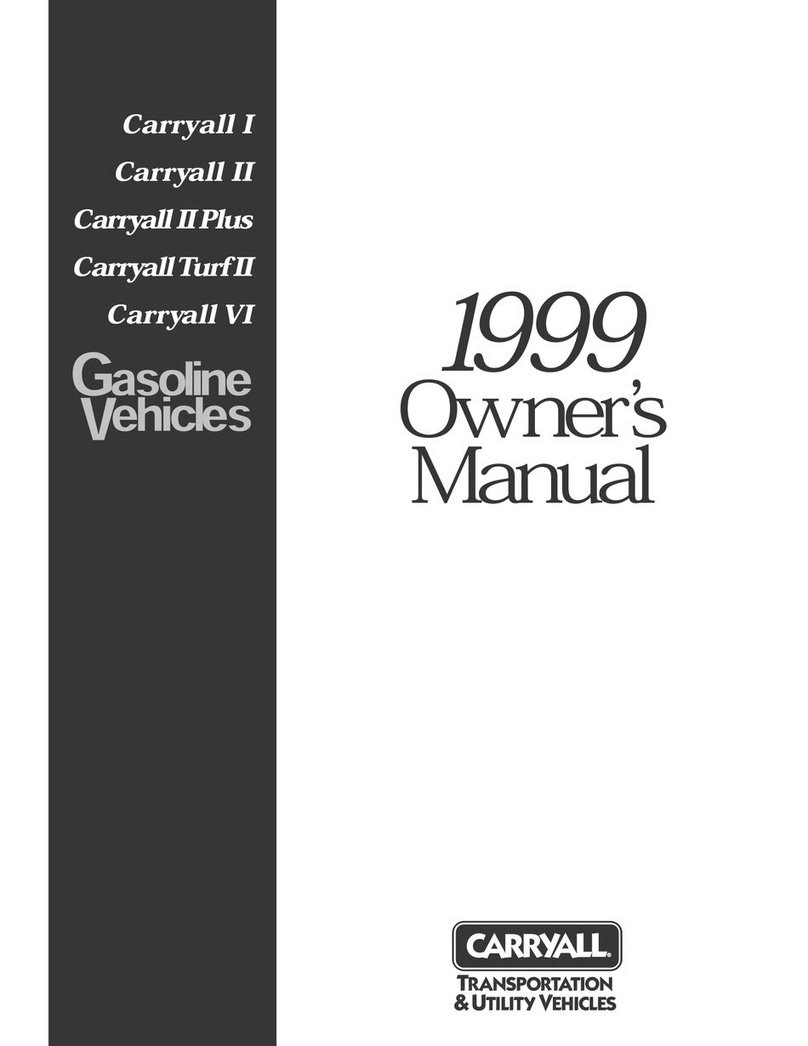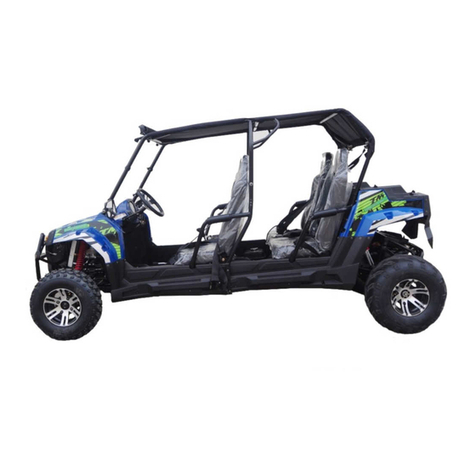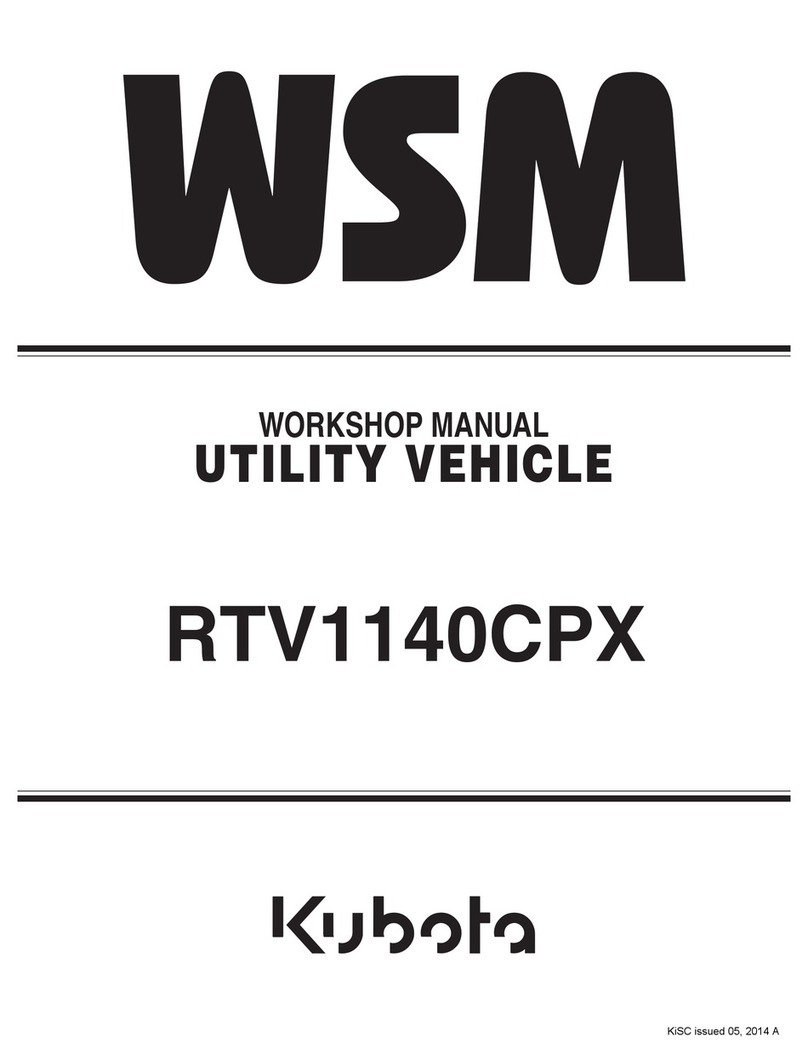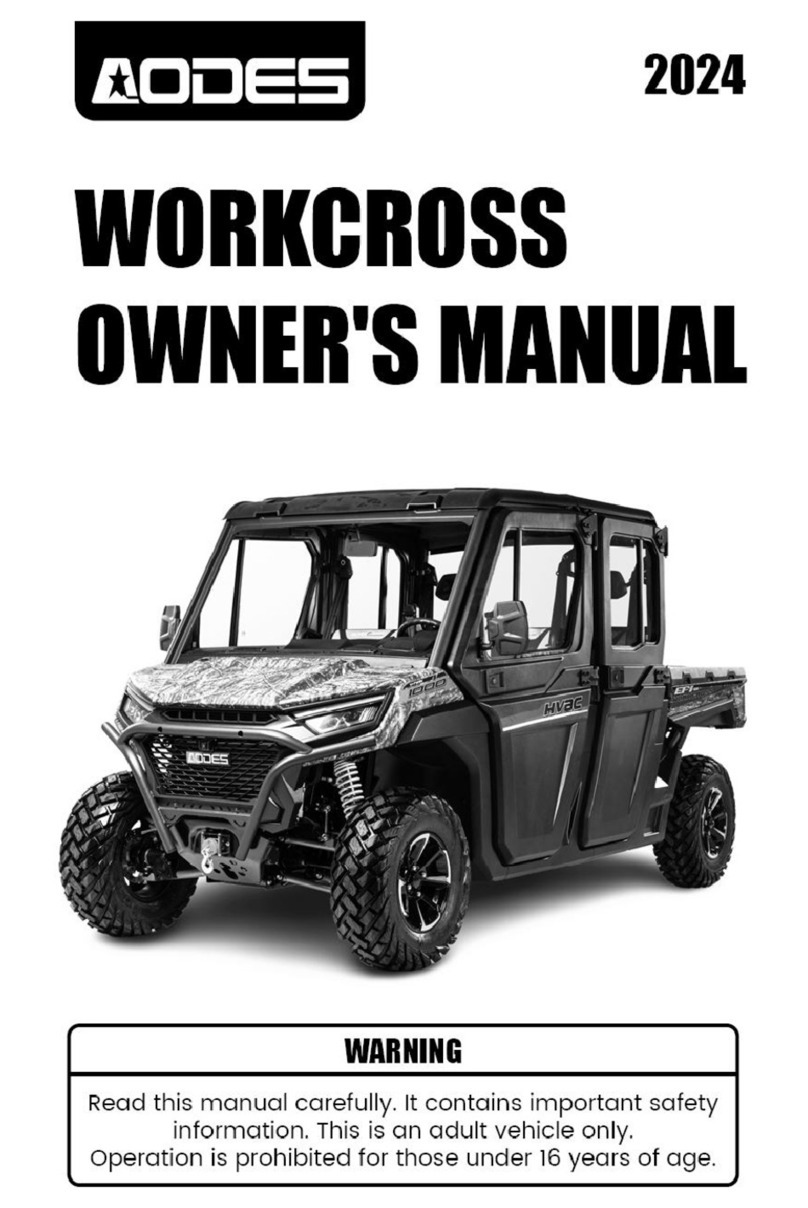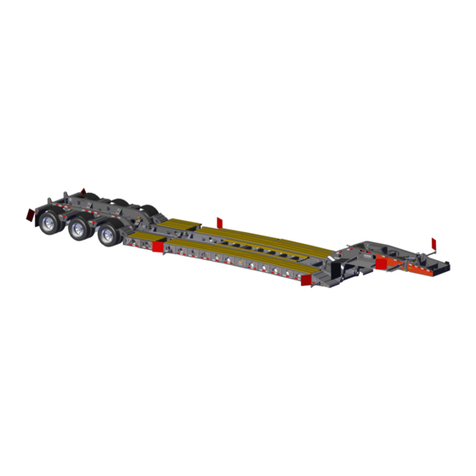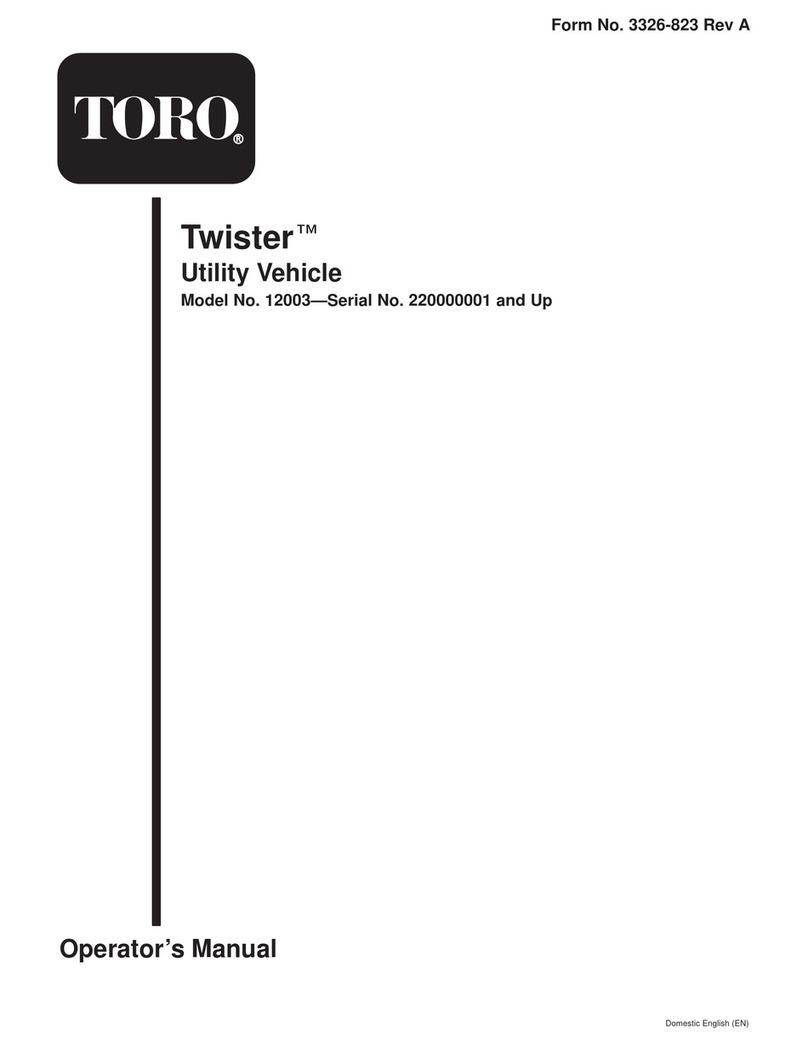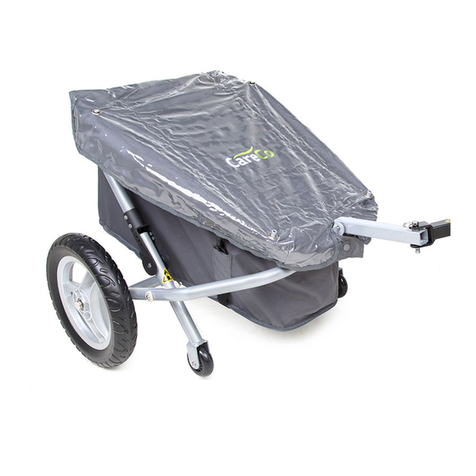Textron EZGO User manual


(NOTES, CAUTIONS AND WARNINGS CONTINUED ON INSIDE OF BACK COVER)
SAFETY
NOTES, CAUTIONS AND WARNINGS
Throughout this guide NOTE, CAUTION and WARNING
will be used.
A NOTE indicates a condition that should be
observed.
A CAUTION indicates a
condition that may result in
damage to the vehicle.
A WARNING indi-
cates a hazardous
condition that could
result in severe injury or death.
Observe these NOTES, CAUTIONS and WARNINGS;
be aware that servicing a vehicle requires mechanical
skill and a regard for conditions that could be hazardous.
Improper service or repair may damage the vehicle or
render it unsafe.
Engine exhaust from
this product con-
tains chemicals
known, in certain quantities, to cause can-
cer, birth defects, or other reproductive
harm.
The exhaust emissions of this vehicles’ engine
complies with regulations set forth by the Envi-
ronmental Protection Agency (EPA) of the United States of
America (USA) at time of manufacture. Significant fines could
result from modifications or tampering with the engine, fuel,
ignition or air intake systems.
Battery posts, termi-
nals and related
accessories contain
lead and lead compounds. Wash hands after
handling.
This spark ignition system meets all require-
ments of the Canadian Interference-Causing
For any questions on material contained in this manual, contact an authorized representative for clarification.
Read and understand all labels located on the vehicle. Always replace any damaged or missing labels.
On steep hills it is possible for vehicles to coast at greater than normal speeds encountered on a flat surface. To pre-
vent loss of vehicle control and possible serious injury, speeds should be limited to no more than the maximum speed
on level ground. See GENERAL SPECIFICATIONS. Limit speed by applying the service brake.
Catastrophic damage to the drivetrain components due to excessive speed may result from driving the vehicle above
specified speed. Damage caused by excessive speed may cause a loss of vehicle control, is costly, is considered
abuse and will not be covered under warranty.
For towing/transporting vehicle, refer to “TRANSPORTING VEHICLE”.
Signs similar to the ones illustrated should be used to warn of situations that could result in an unsafe condition.
Be sure that this manual remains as part of the permanent service record should the vehicle be sold.
WASH HANDS
AFTER HANDLING!
Battery posts,
terminals and related
accessories contain
lead and lead compounds,
chemicals known
to cause cancer and
reproductive harm.
BATTERY WARNING
WASH HANDS
AFTER HANDLING!
WARNING: Battery posts, terminals and related
accessories contain lead and lead compounds,
chemicals known to cause cancer and reproductive harm.
BATTERIES
CONTAIN LEAD
AND RELATED PARTS
!
<
14
˚
25
%
DO NOT
DRIVE ACROSS
SLOPES IN
EXCESS OF 14˚

Page i
Owner’s Manual and Service Guide
OWNER’S MANUAL
AND SERVICE GUIDE
GASOLINE POWERED
UTILITY VEHICLES
ST SPORT II™
Starting Model Year 2006
REVISED MAY 2006
This vehicle has been designed and manufactured in the
United States of America (USA) as a ‘World Vehicle’. The
Standards and Specifications listed in the following text
originate in the USA unless otherwise indicated.
E-Z-GO Division of TEXTRON, Inc. reserves the right to make design changes without obligation to make these changes on units previously sold and the infor-
mation contained in this manual is subject to change without notice.
E-Z-GO Division of TEXTRON, Inc. is not liable for errors in this manual or for incidental or consequential damages that result from the use of the material in this
manual.
TO CONTACT US
NORTH AMERICA:
TECHNICAL ASSISTANCE & WARRANTY PHONE: 1-800-774-3946, FAX: 1-800-448-8124
SERVICE PARTS PHONE: 1-888-GET-EZGO (1-888-438-3946), FAX: 1-800-752-6175
INTERNATIONAL:
PHONE: 010-1-706-798-4311, FAX: 010-1-706-771-4609
E-Z-GO DIVISION OF TEXTRON, INC., 1451 MARVIN GRIFFIN ROAD, AUGUSTA, GEORGIA USA 30906-3852

Page ii Owner’s Manual and Service Guide
GENERAL INFORMATION
The use of non Original Equipment Manufacturer (OEM) approved parts may void the
warranty.
Overfilling battery may void the warranty.
Tampering with or adjusting the governor to permit vehicle to operate at above factory
specifications will void the vehicle warranty.
When servicing engines, all adjustments and replacement components must be per original
vehicle specifications in order to maintain the United States of America Federal and State
emission certification applicable at the time of manufacture.
BATTERY PROLONGED STORAGE
All batteries will self discharge over time. The rate of self discharge varies depending on the
ambient temperature and the age and condition of the batteries.
A fully charged battery will not freeze in winter temperatures unless the temperature falls
below -75° F (-60° C).

Page iii
Owner’s Manual and Service Guide
TABLE OF CONTENTS
SAFETY ................................................................................................................ inside covers
GENERAL INFORMATION ....................................................................................................... ii
SAFETY INFORMATION ........................................................................................................... v
BEFORE INITIAL USE .............................................................................................................. 1
Fig. 1 Initial Service Chart .........................................................................................................1
CONTROLS AND INDICATORS ............................................................................................... 1
KEY/LIGHT SWITCH ...........................................................................................................................................1
Fig. 2 Key/Light Switch, Low Oil Pressure Light and Fuel Gauge ............................................2
DIRECTION SELECTOR .....................................................................................................................................2
Fig. 3 Direction Selector ...........................................................................................................2
CHOKE ................................................................................................................................................................2
FUEL GAUGE ......................................................................................................................................................2
LOW OIL PRESSURE INDICATOR LIGHT .........................................................................................................2
Fig. 4 Choke .............................................................................................................................2
ACCELERATOR PEDAL .....................................................................................................................................2
Fig. 5 Accelerator, Brake and Horn Controls ............................................................................2
COMBINATION BRAKE AND PARK BRAKE PEDAL .........................................................................................2
HORN ...................................................................................................................................................................3
PLASTIC LOAD BED ................................................................................................................ 3
MANUAL LIFT BED OPERATION .......................................................................................................................3
Fig. 6 Manual Bed Latch ...........................................................................................................3
OPERATING THE VEHICLE ..................................................................................................... 3
RUN-IN ................................................................................................................................................................4
Fig. 7 Check Oil Level on Dipstick ............................................................................................4
COLD STARTING ................................................................................................................................................4
STARTING AND DRIVING ..................................................................................................................................4
STARTING THE VEHICLE ON A HILL ................................................................................................................5
COASTING ..........................................................................................................................................................5
FUEL ....................................................................................................................................................................5
Fig. 8 Fueling ............................................................................................................................6
BATTERY ............................................................................................................................................................6
LABELS AND PICTOGRAMS .............................................................................................................................6
SUN TOP AND WINDSHIELD .............................................................................................................................6
TOWING A TRAILER ..........................................................................................................................................6
VEHICLE CLEANING AND CARE ............................................................................................ 6
VEHICLE CLEANING ..........................................................................................................................................6
REPAIR ..................................................................................................................................... 8
LIFTING THE VEHICLE ......................................................................................................................................8
Fig. 9 Lifting the Vehicle ...........................................................................................................8
WHEELS AND TIRES .........................................................................................................................................9
Fig. 10 Wheel Installation .........................................................................................................9
LIGHT BULB REPLACEMENT ............................................................................................................................9
Fig. 11 Headlight Replacement ...............................................................................................9
FUSE REPLACEMENT .......................................................................................................................................9
VEHICLE WITH A DISCHARGED BATTERY ...................................................................................................10
TRANSPORTING VEHICLE .................................................................................................... 10
TOWING ............................................................................................................................................................10
NEUTRAL LOCK ...............................................................................................................................................10
Fig. 12 Neutral Lock ................................................................................................................10
HAULING ...........................................................................................................................................................10
SERVICE AND MAINTENANCE ............................................................................................. 10
SERIAL NUMBER LABEL LOCATION ..............................................................................................................11
PERIODIC SERVICE SCHEDULE ...................................................................................................................12
Fig. 13 Periodic Service Schedule ..........................................................................................12
TIRE INSPECTION ............................................................................................................................................12

Page iv Owner’s Manual and Service Guide
TABLE OF CONTENTS
CHECKING THE OIL LEVEL ............................................................................................................................ 13
Fig. 14 Clean Entire Dipstick .................................................................................................. 13
Fig. 15 Check Oil Level on Dipstick ....................................................................................... 13
CHANGING THE OIL ........................................................................................................................................ 14
Fig. 16 Oil Viscosity Chart ...................................................................................................... 14
Fig. 17 Clean Top of Engine .................................................................................................. 14
Fig. 18 Remove Oil Filter ....................................................................................................... 15
Fig. 19 Clean Oil Filter ........................................................................................................... 15
Fig. 20 Blowing Out Oil Filter ................................................................................................. 15
Fig. 21 Add Engine Oil ........................................................................................................... 15
STARTER/GENERATOR BELT TENSION ....................................................................................................... 15
Fig. 22 Checking Belt Tension with Gauge ............................................................................ 16
Fig. 23 Checking Belt Tension Manually ................................................................................ 16
Fig. 24 Adjusting Belt Tension ............................................................................................... 16
BATTERY CLEANING ...................................................................................................................................... 16
Fig. 25 Preparing Acid Neutralizing Solution .......................................................................... 17
BRAKES .......................................................................................................................................................... 17
Fig. 26 Typical Brake Performance Test ................................................................................ 17
AIR INTAKE AND COOLING FINS ................................................................................................................... 18
Fig. 27 Cleaning Air Intake ..................................................................................................... 18
Fig. 28 Cleaning the Cooling Fins .......................................................................................... 18
REAR AXLE ...................................................................................................................................................... 18
Fig. 29 Add, Check and Drain Rear Axle Lubricant ............................................................... 19
AIR CLEANER INSPECTION AND REPLACEMENT ....................................................................................... 19
Fig. 30 Canister Type Air Cleaner .......................................................................................... 19
LUBRICATION .................................................................................................................................................. 19
Fig. 31 Lubrication Points ....................................................................................................... 19
SPARK PLUGS ................................................................................................................................................. 19
PROLONGED STORAGE ................................................................................................................................ 20
HARDWARE ..................................................................................................................................................... 21
Fig. 32 Torque Specifications .................................................................................................21
CAPACITIES AND REPLACEMENT PARTS .................................................................................................. 21
Fig. 33 Capacities and Replacement Parts ............................................................................ 21
GENERAL SPECIFICATIONS .................................................................................................. 23
ST SPORT II™I .................................................................................................................................................. 24
Fig. 34 Vehicle Dimensions, Incline Specifications ................................................................. 25
Fig. 35 Turning Clearance Diameter ....................................................................................... 26
VEHICLE WARRANTIES..........................................................................................................27
DOMESTIC WARRANTY .................................................................................................................................. 28
INTERNATIONAL WARRANTY (2004) ............................................................................................................. 29
FEDERAL EMISSION COMPONENT DEFECT WARRANTY........................................................................... 31
CALIFORNIA EMISSION CONTROL WARRANTY STATEMENT .................................................................... 33
DECLARATION OF CONFORMITY (EUROPE ONLY)............................................................ 35
LABELS AND PICTOGRAMS ..................................................................................Appendix A

Owner’s Manual and Service Guide Page v
SAFETY INFORMATION
This manual has been designed to assist in maintaining the vehicle in accordance with procedures developed by the
manufacturer. Adherence to these procedures and troubleshooting tips will ensure the best possible service from the
product. To reduce the chance of personal injury or property damage, the following must be carefully observed:
Certain replacement parts can be used independently and/or in combination with other accessories to modify an E-Z-
GO-manufactured vehicle to permit the vehicle to operate at or in excess of 20mph. When an E-Z-GO-manufactured
vehicle is modified an any way by the Distributor, Dealer or customer to operate at or in excess of 20mph, UNDER
FERERAL LAW the modified product will be a Low Speed Vehicle (LSV) subject to the strictures and requirements of
Federal Motor Vehicle Safety Standard 571.500. In these instances, pursuant to Federal law the Distributor or Dealer
MUST equip the product with headlights, rear lights, turn signals, seat belts, top, horn and all other modifications for
LSV’s mandated in FMVSS 571.500, and affix a Vehicle Identification Number to the product in accordance with the
requirements of FMVSS 571.565. Pursuant to FMVSS 571.500, and in accordance with the State laws applicable in the
places of sale and use of the product, the Distributor, Dealer or customer modifying the vehicle also will be the Final
Vehicle Manufacturer for the LSV, and required to title or register the vehicle as mandated by State law.
E-Z-GO will NOT approve Distributor, Dealer or customer modifications converting E-Z-GO products into LSV’s.
The Company, in addition, recommends that all E-Z-GO products sold as personal transportation vehicles BE OPER-
ATED ONLY BY PERSONS WITH VALID DRIVERS LICENSES, AND IN ACCORDANCE WITH APPLICABLE STATE
REQUIREMENTS. This restriction is important to the SAFE USE AND OPERATION of the product. On behalf of E-Z-
GO, I am directing that E-Z-GO Branch personnel, Distributors and Dealers advise all customers to adhere to this
SAFETY RESTRICTION, in connection with the use of all products, new and used, the Distributor or Dealer has rea-
son to believe may be operated in personal transportation applications.
Information on FMVSS 571.500 can be obtained at Title 49 of the Code of Federal Regulations, section 571.500, or
through the Internet at the website for the U.S. Department of Transportation - at Dockets and Regulation, then to Title
49 of the Code of Federal Regulations (Transportation).
GENERAL
Many vehicles are used for a variety of tasks beyond the original intended use of the vehicle; therefore, it is impossible
to anticipate and warn against every possible combination of circumstances that may occur. No warnings can take the
place of good common sense and prudent driving practices.
Good common sense and prudent driving practices do more to prevent accidents and injury than all of the warnings
and instructions combined. The manufacturer strongly suggests that all users and maintenance personnel read this
entire manual paying particular attention to the CAUTIONS and WARNINGS contained therein.
If you have any questions regarding this vehicle, contact your closest representative or write to the address on the back
cover of this publication, Attention: Product Service Department.
The manufacturer reserves the right to make design changes without obligation to make these changes on units previ-
ously sold and the information contained in this manual is subject to change without notice.
The manufacturer is not liable for errors in this manual or for incidental or consequential damages that result from the
use of the material in this manual.

Owner’s Manual and Service Guide
Page vi
SAFETY INFORMATION
This vehicle conforms to the current applicable standard(s) for safety and performance requirements.
These vehicles are designed and manufactured for off-road use. They do not conform to Federal Motor Vehicle Safety
Standards of the United States of America (USA) and are not equipped for operation on public streets. Some commu-
nities may permit these vehicles to be operated on their streets on a limited basis and in accordance with local ordi-
nances.
Refer to GENERAL SPECIFICATIONS for vehicle seating capacity.
Never modify the vehicle in any way that will alter the weight distribution of the vehicle, decrease its stability
or increase the speed beyond the factory specification. Such modifications can cause serious personal injury
or death. Modifications that increase the speed and/or weight of the vehicle will extend the stopping distance and may
reduce the stability of the vehicle. Do not make any such modifications or changes. The manufacturer prohibits and
disclaims responsibility for any such modifications or any other alteration which would adversely affect the safety of the
vehicle.
Vehicles that are capable of higher speeds must limit their speed to no more than the speed of other vehicles when
used in a golf course environment. Additionally, speed should be further moderated by the environmental conditions,
terrain and common sense.
GENERAL OPERATION
Always:
• Use the vehicle in a responsible manner and maintain the vehicle in safe operating condition.
• Read and observe all warnings and operation instruction labels affixed to the vehicle.
• Follow all safety rules established in the area where the vehicle is being operated.
• Reduce speed to compensate for poor terrain or conditions.
• Apply service brake to control speed on steep grades.
• Maintain adequate distance between vehicles.
• Reduce speed in wet areas.
• Use extreme caution when approaching sharp or blind turns.
• Use extreme caution when driving over loose terrain.
• Use extreme caution in areas where pedestrians are present.
MAINTENANCE
Always:
• Maintain the vehicle in accordance with the manufacturer’s periodic service schedule.
• Ensure that repairs are performed by those that are trained and qualified to do so.
• Follow the manufacturer’s maintenance procedures for the vehicle. Be sure to disable the vehicle before performing
any maintenance. Disabling includes removing the key from the key switch and removal of a battery wire.
• Insulate any tools used within the battery area in order to prevent sparks or battery explosion caused by shorting the

Owner’s Manual and Service Guide Page vii
SAFETY INFORMATION
battery terminals or associated wiring. Remove the battery or cover exposed terminals with an insulating material.
• Use specified replacement parts. Never use replacement parts of lesser quality.
• Use recommended tools.
• Determine that tools and procedures not specifically recommended by the manufacturer will not compromise the
safety of personnel nor jeopardize the safe operation of the vehicle.
• Support the vehicle using wheel chocks and jack stands. Never get under a vehicle that is supported by a jack. Lift
the vehicle in accordance with the manufacturer’s instructions.
• Empty the fuel tank or plug fuel hoses to prevent fuel leakage.
• Maintain the vehicle in an area away from exposed flame or persons who are smoking.
• Be aware that a vehicle that is not performing as designed is a potential hazard and must not be operated.
• Test drive the vehicle after any repairs or maintenance. All tests must be conducted in a safe area that is free of both
vehicular and pedestrian traffic.
• Replace damaged or missing warning, caution or information labels.
• Keep complete records of the maintenance history of the vehicle.
The manufacturer cannot anticipate all situations, therefore people attempting to maintain or repair the vehicle must
have the skill and experience to recognize and protect themselves from potential situations that could result in severe
personal injury or death and damage to the vehicle. Use extreme caution and, if unsure as to the potential for injury,
refer the repair or maintenance to a qualified mechanic.
VENTILATION
Always store gasoline vehicles in a well ventilated area. Ventilation prevents gasoline fumes from accumulating.
Never fuel a vehicle in an area that is subject to flame or spark. Pay particular attention to natural gas or propane water
heaters and furnaces.
Never work around or operate a vehicle in an environment that does not ventilate exhaust gases from the area. Carbon
monoxide is a dangerous gas that can cause unconsciousness and is potentially lethal.

Owner’s Manual and Service Guide
Page viii
SAFETY INFORMATION
Notes:

Owner’s Manual and Service Guide Page ix
SAFETY INFORMATION
GENERAL
The following text is provided as recommended by part II of ASME/ANSI B56.8-2005. E-Z-GO strongly endorses the
contents of this specification.
PART II
FOR THE USER
4 GENERAL SAFETY PRACTICES
4.1 Introduction
4.1.1 Like other machines, carriers can cause injury if improperly used or maintained. Part II contains broad safety
practices applicable to carrier operations. Before operation, the user shall establish such additional specific safety
practices as may reasonably be required for safe operation.
4.2 Stability
4.2.1 Experience has shown that carriers which comply with the provisions stated in para. 7.3.9 are stable when
properly operated and when operated in accordance with specific safety rules and practices established to meet actual
operating terrain and conditions. However, improper operation, faulty maintenance, or poor housekeeping may contrib-
ute to a condition of instability and defeat the purpose of the standard. Some of the conditions which may affect stability
are failure of the user to follow safety practices; also, ground and floor conditions, grade, speed, loading, the operation
of the carrier with improper loads, battery weight, dynamic and static forces, and the judgement exercised by the car-
rier operator.
(a) The user shall train carrier operators to adhere strictly to the operating instructions stated in this Standard.
(b) The user shall survey specific operating conditions and environment, and establish and train carrier operators to
comply with additional, specific safety practices.
4.3 Nameplates, Markings, Capacity, and Modifications
4.3.1 The user shall maintain in a legible condition all nameplates, warnings, and instructions which are supplied
by the manufacturer.
4.3.2 The user shall not perform any modification or addition which affects capacity or safe operation, or make any
change not in accordance with the owner’s manual without the manufacturer’s prior written authorization. Where
authorized modifications have been made, the user shall ensure that capacity, operation, warning, and maintenance
instruction plates, tags, or decals are changed accordingly.
4.3.3 As required under paras. 4.3.1 or 4.3.2, the manufacturer shall be contacted to secure new nameplates,
warnings, or instructions which shall then be affixed in their proper place on the carrier.
4.4 Fuel Handling and Storage
4.4.1 The user shall supervise the storage and handling of liquid fuels (when used) to be certain that it is in accor-
dance with appropriate paragraphs of ANSI/NFPA 505 and ANSI/NFPA 30.
4.4.2 Storage and handling of liquefied petroleum gas fuels shall be in accordance with appropriate paragraphs of
ANSI/NFPA 505 and ANSI/NFPA 58. If such storage or handling is not in compliance with these standards, the user
shall prevent the carrier from being used until such storage and handling is in compliance with these standards.
4.5 Changing and Charging Storage Batteries for Electric Personnel and Burden Carriers
4.5.1 The user shall require battery changing and charging facilities and procedures to be in accordance with
appropriate paragraphs of ANSI/NFPA 505.

Owner’s Manual and Service Guide
Page x
SAFETY INFORMATION
4.5.2 The user shall periodically inspect facilities and review procedures to be certain that appropriate paragraphs
of ANSI/NFPA 505, are strictly complied with, and shall familiarize carrier operators with it.
4.6 Hazardous Locations
4.6.1 The user shall determine the hazard classification of the particular atmosphere or location in which the car-
rier is to be used in accordance with ANSI/NFPA 505.
4.6.2 The user shall permit in hazardous areas only those carriers approved and of the type required by ANSI/
NFPA 505.
4.7 Lighting for Operating Areas
4.7.1 The user, in accordance with his responsibility to survey the environment and operating conditions, shall
determine if the carrier requires lights and, if so, shall equip the carrier with appropriate lights.
4.8 Control of Noxious Gases and Fumes
4.8.1 When equipment powered by internal combustion engines is used in enclosed areas, the atmosphere shall
be maintained within limits specified in the American Conference of Governmental Industrial Hygienists publication,
“Threshold Limit Values for Chemical Substances and Physical Agents in the Workroom Environment”. This shall be
accomplished by ventilation provided by the user, and/or the installation, use, and proper maintenance of emission
control equipment recommended or provided by the manufacturer of the equipment.
4.9 Warning Device(s)
4.9.1 The user shall make periodic inspections of the carrier to be certain that the sound-producing and/or visual
device(s) are maintained in good operating condition.
4.9.2 The user shall determine if operating conditions require the carrier to be equipped with additional sound-pro-
ducing and/or visual devices and be responsible for providing and maintaining such devices, in accordance with the
manufacturer’s recommendations.
5 OPERATING SAFETY RULES AND PRACTICES
5.1 Personnel and Burden Carrier Operator Qualifications
5.1.1 Only persons who are trained in the proper operation of the carrier shall be authorized to operate the carrier.
Operators shall be qualified as to visual, auditory, physical, and mental ability to safely operate the equipment accord-
ing to Section 5 and all other applicable parts of this Standard.
5.2 Personnel and Burden Carrier Operators’ Training
5.2.1 The user shall conduct an operators’ training program.
5.2.2 Successful completion of the operators’ training program shall be required by the user before operation of
the carrier. The program shall be presented in its entirety to all new operators and not condensed for those claiming
previous experience.
5.2.3 The user should include in the operators’ training program the following:
(a) instructional material provided by the manufacturer;
(b) emphasis on safety of passengers, material loads, carrier operator, and other employees;
(c) general safety rules contained within this Standard and the additional specific rules determined by the user in
accordance with this Standard, and why they were formulated;
(d) introduction of equipment, control locations and functions, and explanation of how they work when used properly
and when used improperly, and surface conditions, grade, and other conditions of the environment in which the carrier

Owner’s Manual and Service Guide Page xi
SAFETY INFORMATION
is to be operated;
(e) operational performance tests and evaluations during, and at completion of, the program.
5.3 Personnel and Burden Carrier Operator Responsibility
5.3.1 Operators shall abide by the following safety rules and practices in paras. 5.4, 5.5, 5.6, and 5.7.
5.4 General
5.4.1 Safeguard the pedestrians at all times. Do not drive carrier in a manner that would endanger anyone.
5.4.2 Riding on the carrier by persons other than the operator is authorized only on personnel seat(s) provided by
the manufacturer. All parts of the body shall remain within the plan view outline of the carrier.
5.4.3 When a carrier is to be left unattended, stop carrier, apply the parking brake, stop the engine or turn off
power, turn off the control or ignition circuit, and remove the key if provided. Block the wheels if machine is on an
incline.
5.4.4 A carrier is considered unattended when the operator is 25 ft. (7.6 m) or more from the carrier which remains
in his view, or whenever the operator leaves the carrier and it is not within his view. When the operator is dismounted
and within 25 ft. (7.6 m) of the carrier still in his view, he still must have controls neutralized, and the parking brake(s)
set to prevent movement.
5.4.5 Maintain a safe distance from the edge of ramps and platforms.
5.4.6 Use only approved carriers in hazardous locations, as defined in the appropriate safety standards.
5.4.7 Report all accidents involving personnel, building structures, and equipment.
5.4.8 Operators shall not add to, or modify, the carrier.
5.4.9 Carriers shall not be parked or left unattended such that they block or obstruct fire aisles, access to stair-
ways, or fire equipment.
5.5 Traveling
5.5.1 Observe all traffic regulations, including authorized speed limits. Under normal traffic conditions keep to the
right. Maintain a safe distance, based on speed of travel, from a carrier or vehicle ahead; and keep the carrier under
control at all times.
5.5.2 Yield the right of way to pedestrians, ambulances, fire trucks, or other carriers or vehicles in emergency sit-
uations.
5.5.3 Do not pass another carrier or vehicle traveling in the same direction at intersections, blind spots, or at other
dangerous locations.
5.5.4 Keep a clear view of the path of travel, observe other traffic and personnel, and maintain a safe clearance.
5.5.5 Slow down or stop, as conditions dictate, and activate the sound-producing warning device at cross aisles
and when visibility is obstructed at other locations.
5.5.6 Ascend or descend grades slowly.
5.5.7 Avoid turning, if possible, and use extreme caution on grades, ramps, or inclines; normally travel straight up
and down.
5.5.8 Under all travel conditions the carrier shall be operated at a speed that will permit it to be brought to a stop in
a safe manner.
5.5.9 Make starts, stops, turns, or direction reversals in a smooth manner so as not to shift the load, endanger
passengers, or overturn the carrier.
5.5.10 Do not indulge in dangerous activities, such as stunt driving or horseplay.
5.5.11 Slow down when approaching, or on, wet or slippery surfaces.

Owner’s Manual and Service Guide
Page xii
SAFETY INFORMATION
5.5.12 Do not drive carrier onto any elevator unless specifically authorized to do so. Approach elevators slowly, and
then enter squarely after the elevator car is properly leveled. Once on the elevator, neutralize the controls, shut off
power, and set parking brakes. It is advisable that all other personnel leave the elevator before a carrier is allowed to
enter or exit.
5.5.13 Avoid running over loose objects, potholes, and bumps.
5.5.14 To negotiate turns, reduce speed to improve stability, then turn hand steering wheel or tiller in a smooth,
sweeping motion.
5.6 Loading
5.6.1 Handle only stable and safely arranged loads. When handling off-center loads which cannot be centered,
operate with extra caution.
5.6.2 Handle only loads within the capacity of the carrier as specified on the nameplate.
5.6.3 Handle loads exceeding the dimensions used to establish carrier capacity with extra caution. Stability and
maneuverability may be adversely affected.
5.7 Operator Care of Personnel and Burden Carriers
5.7.1 At the beginning of each shift during which the carrier will be used, the operator shall check the carrier con-
dition and inspect the tires, warning devices, lights, battery(s), speed and directional controllers, brakes, and steering
mechanism. If the carrier is found to be in need of repair, or in any way unsafe, the matter shall be reported immedi-
ately to the designated authority and the carrier shall not be operated until it has been restored to safe operating condi-
tion.
5.7.2 If during operation the carrier becomes unsafe in any way, the matter shall be reported immediately to the
designated authority, and the carrier shall not be operated until it has been restored to safe operating condition.
5.7.3 Do not make repairs or adjustments unless specifically authorized to do so.
5.7.4 The engine shall be stopped and the operator shall leave the carrier while refueling.
5.7.5 Spillage of oil or fuel shall be carefully and completely absorbed or evaporated and fuel tank cap replaced
before starting engine.
5.7.6 Do not operate a carrier with a leak in the fuel system or battery(s).
5.7.7 Do not use open flames for checking electrolyte level in storage battery(s) or liquid level in fuel tanks.
6 MAINTENANCE PRACTICES
6.1 Introduction
6.1.1 Carriers may become hazardous if maintenance is neglected. Therefore, maintenance facilities, trained per-
sonnel, and procedures shall be provided. Such facilities may be on or off the premises.
6.2 Maintenance Procedures
6.2.1 Maintenance and inspection of all carriers shall be performed in conformance with the manufacturer’s rec-
ommendations and the following practices.
(a) A scheduled preventive maintenance, lubrication, and inspection system shall be followed.
(b) Only qualified and authorized personnel shall be permitted to maintain, repair, adjust, and inspect carriers.
(c) Before undertaking maintenance or repair, follow the manufacturer’s recommendations for immobilizing the car-
rier.
(d) Block chassis before working underneath it.

Owner’s Manual and Service Guide Page xiii
SAFETY INFORMATION
(e) Before disconnecting any part of the engine fuel system of a gasoline or diesel powered carrier with gravity feed
fuel systems, be sure shutoff valve is closed, and run engine until fuel system is depleted and engine stops running.
(f) Before disconnecting any part of the engine fuel system of LP gas powered carriers, close the LP gas cylinder
valve and run the engine until fuel in the system is depleted and the engine stops running.
(g) Operation to check performance of the carrier shall be conducted in an authorized area where safe clearance
exists.
(h) Before commencing operation of the carrier, follow the manufacturer’s instructions and recommended proce-
dures.
(i) Avoid fire hazards and have fire protection equipment present in the work area. Do not use an open flame to
check level or leakage of fuel, battery electrolyte, or coolant. Do not use open pans of fuel or flammable cleaning fluids
for cleaning parts.
(j) Properly ventilate the work area.
(k) Handle LP gas cylinders with care. Physical damage, such as dents, scrapes, or gouges, may dangerously
weaken the tank and make it unsafe for use.
(l) Brakes, steering mechanisms, speed and directional control mechanisms, warning devices, lights, governors,
guards, and safety devices shall be inspected regularly and maintained in a safe operating condition.
(m) Special carriers or devices designed and approved for hazardous area operation shall be inspected to ensure
that maintenance preserves the original approved safe operating features.
(n) Fuel systems shall be checked for leaks and condition of parts. If a leak is found, action shall be taken to prevent
the use of the carrier until the leak has been eliminated.
(o) The carrier manufacturer’s capacity, operation, and maintenance instruction plates, tags, or decals shall be
maintained in legible condition.
(p) Batteries, motors, speed and directional controllers, limit switches, protective devices, electrical conductors, and
connections shall be inspected and maintained.
(q) Carriers shall be kept in a clean condition to minimize fire hazards and facilitate detection of loose or defective
parts.
(r) Modifications and additions which affect capacity and safe machine operation shall not be performed by the cus-
tomer or user without manufacturer’s prior written authorization; where authorized modifications have been made, the
user shall ensure that capacity, operation, warning, and maintenance instruction plates, tags, or decals are changed
accordingly.
(s) Care shall be taken to ensure that all replacement parts are interchangeable with the original parts and of a qual-
ity at least equal to that provided in the original equipment.
END OF ASME/ANSI B56.8-2005 TEXT

Owner’s Manual and Service Guide
Page xiv
SAFETY INFORMATION
Notes:

OPERATION AND SERVICE INFORMATION
Page 1
Owner’s Manual and Service Guide
Read all of Manual to become thoroughly familiar with this vehicle. Pay particular attention to all Notes, Cautions and Warnings
Thank you for purchasing this vehicle. Before driving the
vehicle, we ask you to spend some time reading this
Owner’s Manual and Service Guide. This guide contains
the information that will assist you in maintaining this
highly reliable vehicle. Some illustrations may show
items that are optional for your vehicle. This guide covers
the operation of several vehicles; therefore, some picto-
rial views may not represent your vehicle. Physical differ-
ences in controls will be illustrated.
This vehicle has been designed and manufactured as a
‘World Vehicle’. Some countries have individual require-
ments to comply with their specifications; therefore,
some sections may not apply in your country.
Most of the service procedures in this guide can be
accomplished using common automotive hand tools.
Contact your service representative on servicing the
vehicle in accordance with the Periodic Service Sched-
ule.
Service Parts Manuals and Technician’s Repair and Ser-
vice Manuals are available from a local Distributor, an
authorized Branch or the Service Parts Department.
When ordering parts or requesting information for your
vehicle, provide vehicle model, serial number and manu-
facture code.
BEFORE INITIAL USE
Read, understand and follow the safety label on the
instrument panel. Be sure you understand how to oper-
ate the vehicle, its equipment and how to use it safely.
Maintaining good performance depends to a large extent
on the operator.
Hydrogen gas is
generated as a natu-
ral part of the lead
acid battery charging process. A 4% con-
centration of hydrogen gas is explosive and
could cause severe injury or death. Charg-
ing must take place in an area that is ade-
quately ventilated (minimum of 5 air
exchanges per hour).
To reduce the chance of battery explosion
that could result in severe injury or death,
never smoke around or charge batteries in
an area that has open flame or electrical
equipment that could cause an electrical
arc.
Before a new vehicle is put into operation, the items
shown in the INITIAL SERVICE CHART must be per-
formed (Ref Fig. 1 on page 1).
Vehicle battery must be fully charged before initial use.
Check for correct tire inflation. See GENERAL SPECIFI-
CATIONS.
Check for oil or fuel leaks that could have developed in
shipment from the factory.
Determine and record braking distance required to stop
vehicle for future brake performance tests.
Remove the protective clear plastic, that protect the seat
bottom and back rest during shipping, before placing the
vehicle in service.
CONTROLS AND INDICATORS
Vehicle controls and indicators consist of:
•key/light switch
•direction selector
•choke
•accelerator pedal
•combination service and park brake pedal
•horn
KEY/LIGHT SWITCH
Located on the dash panel, this switch enables the basic
electrical system of the vehicle to be turned on and off by
turning the key. To prevent inadvertent operation of the
vehicle when left unattended, the key should be turned to
the ‘OFF’ position and removed (Ref Fig. 2 on page 2).
If the vehicle is equipped with lights, the key switch has a
position to operate them, indicated by the light icon.
If the vehicle is equipped with factory installed
custom accessories, some accessories remain
Fig. 1 Initial Service Chart
ITEM SERVICE OPERATION
Battery Charge battery
Seats Remove protective plastic covering
Brakes Check operation and adjust if necessary
Establish acceptable stopping distance
Tires Check air pressure (see SPECIFICATIONS)
Fuel Fill tank with correct fuel
Engine Check oil level
Ref Isc 16

OPERATION AND SERVICE INFORMATION
Page 2 Owner’s Manual and Service Guide
Read all of Manual to become thoroughly familiar with this vehicle. Pay particular attention to all Notes, Cautions and Warnings
operational with the key switch in the ‘OFF’ position.
DIRECTION SELECTOR
To reduce the possibility of com-
ponent damage, the vehicle
must be completely stopped before moving the
direction selector.
Located on the seat support panel, this lever permits the
selection of either ‘F’ (forward) or ‘R’ (reverse) (Ref Fig. 3
on page 2). Vehicle should be left in ‘F’ when unattended.
CHOKE
The choke is used to aid cold starting (Ref. Fig. 4 on
page 2). See COLD STARTING section for operating
instructions.
ACCELERATOR PEDAL
Unintentional move-
ment of the acceler-
ator pedal will
release the park brake and may cause the
vehicle to move which could result in
severe injury or death.
With the key switch ‘ON’, depressing the accelerator
pedal starts the engine. When the pedal is released, the
engine will stop (Ref Fig. 5 on page 2). To stop the vehi-
cle more quickly, depress the service brake.
If key switch is ‘ON’ and park brake is set, depressing the
accelerator inadvertently will release the park brake and
will cause the vehicle to move which could cause severe
injury or death.
Depressing the accelerator pedal will release the park
brake if it is engaged. This is a feature to assure the vehi-
cle is not driven with the park brake engaged. Depress-
ing the accelerator pedal is not the preferred method of
releasing the park brake.
Depressing the lower section of the brake
pedal is the preferred method of releasing the
park brake to assure the longest service life of brake compo-
nents.
COMBINATION SERVICE AND PARK BRAKE
PEDAL
The brake pedal incorporates a park brake feature (Ref
Fig. 5 on page 2). To engage, push down on the upper
section of the pedal until it locks in place. The park brake
will release when the service brake pedal is depressed.
Use the lower section of the brake pedal to operate the
service brake system.
Fig. 2 Key / Light Switch
Fig. 3 Direction Selector
Fig. 4 Choke
OFF
OFF
ON
ON
R
ef Kes 11
Key/Light Switch
Forward
Reverse
Ref Dsl 2
Choke
Ref Chk 1
Fig. 5 Accelerator, Brake and Horn Controls
Park
Brake
Accelerator
PARK
Service
Brake
Ref Abc 1
Horn

OPERATION AND SERVICE INFORMATION
Page 3
Owner’s Manual and Service Guide
Read all of Manual to become thoroughly familiar with this vehicle. Pay particular attention to all Notes, Cautions and Warnings
HORN
The horn is operated by pushing the horn button located
on the floor to the left of the brake pedal (Ref Fig. 5 on
page 2)
PLASTIC LOAD BED
The manual lift bed is the standard bed for the vehicle.
The bed may be equipped with an optional electric lift
switch.
Failure to follow
these instructions
may result in per-
sonal injury, damage the vehicle and/or
cause the vehicle to tip over. Operate the
vehicle with awareness of the load. Read,
understand and follow the Danger label
affixed to the front of the load bed.
Do not permit anyone to ride in the bed.
Before operating, check to ensure no one is
behind the vehicle.
A load bed warning label is affixed to the inside front of
the bed (see Appendix A). This label must be understood
and observed at all times for safe operation of the vehi-
cle. See the load bed warning label for maximum load.
The load must be positioned in the bed as far forward as
possible, distributed in such a way that its center of grav-
ity must not be higher than height noted on label, and
securely fastened down. Failure to follow these instruc-
tions may result in severe personal injury, damage the
vehicle and/or cause the vehicle to tip over. Operate the
vehicle with awareness of the load.
Do not permit anyone to ride in the bed.
Do not drive the vehicle with the load bed raised or with
the tailgate unsupported.
Never fill a gas can
in the bed of a vehi-
cle. Static dis-
charge could ignite gasoline vapor and
cause an explosion.
Always place a gas can on the ground before filling.
Never fill a gas can in the bed of the vehicle. Static elec-
tricity is built up during the fueling process and could dis-
charge causing the gasoline vapor to ignite.
MANUAL LIFT BED OPERATION
Exercise caution
while operating the
manual lift bed to
ensure the bed is not released during lifting
or lowering procedure. Severe injury could
result if bed is released and traps fingers or
other body parts.
To raise the manual lift bed, pull back on the latch release
handle immediately behind the driver seat (Ref Fig. 6 on
page 3). Raise the bed using the handle on the side of
the bed.
To lower the manual lift bed, grasp the bed handle and
lower the bed to the rest position. Be sure hands are
not trapped by the bed.
TAIL GATE OPERATION
To open the tail gate, lift tail gate straight up with a sharp
upward pull to lift out of the closed position and pivot out
for open position. To remove the tail gate, remove the
side cables from the loadbed and open tail gate until it is
straight down, move tail gate panel straight up to remove
from pins and remove from the load bed. Reassemble in
reverse order.
OPERATING THE VEHICLE
Improper use of the vehicle or
the lack of proper maintenance
may result in damage or decreased performance.
Read and understand the following warnings before
attempting to operate the vehicle.
To reduce the possi-
bility of severe inju-
ry or death resulting
Fig. 6 Manual Bed Latch
Ref Mbl 3
Front of Vehicle
Manual Load Bed Latch
Move Rearward to release

OPERATION AND SERVICE INFORMATION
Page 4 Owner’s Manual and Service Guide
Read all of Manual to become thoroughly familiar with this vehicle. Pay particular attention to all Notes, Cautions and Warnings
from loss of vehicle control, the following
warnings must be observed:
When driving vehicle, consider the ter-
rain, traffic conditions and the environ-
mental factors which effect the terrain
and the ability to control the vehicle.
Use extra care and reduced speed when
driving on poor surfaces, such as loose
dirt, wet grass, gravel, etc.
Stay in designated areas and avoid
extremely rough terrain.
Maintain a safe speed when driving
down hill. Use service brake to control
speed when traveling down an incline. A
sudden stop or change of direction may
result in loss of control.
Slow down before and during turns. All
turns should be made at reduced speed.
Never drive vehicle up, down, or across
an incline that exceeds 14° (25% grade).
To reduce the possi-
bility of severe inju-
ry or death resulting
from improper vehicle operation, the follow-
ing warnings must be observed:
Refer to GENERAL SPECIFICATIONS for
seating capacity.
Depressing accelerator pedal will
release foot operated park brake and
may cause inadvertent vehicle move-
ment. Turn the key to the ‘OFF’ position
whenever the vehicle is parked.
To prevent inadvertent movement when
the vehicle is to be left unattended,
engage the park brake, move direction
selector to forward position, turn key to
‘OFF’ position and remove key.
Make sure that the direction selector is
in correct position before attempting to
start the vehicle.
Always bring the vehicle to a complete
stop before shifting the direction selec-
tor.
Do not take vehicle out of ‘gear’ while in
motion (coast).
Check the area behind the vehicle before
operating in reverse.
All occupants must be seated. Keep
entire body inside vehicle and hold on
while vehicle is in motion.
RUN-IN
Check for oil or fuel leaks that could have developed in
shipment from the factory. Avoid full throttle starts and
rapid acceleration until the engine has achieved operat-
ing temperature.
All engines consume more oil than normal during the first
hours of operation. As internal moving parts are run-in,
oil consumption should gradually decrease until the rate
of consumption stabilizes.
Check the oil level per the Periodic Service Schedule.
Add oil if the level on the dipstick indicates that oil is in
the add oil range (Ref Fig. 7 on page 4).
Do not overfill engine. Too much
oil may cause smoking or allow
oil to enter the air filter enclosure.
Both the oil dipstick and fill cap must be in
place before operating the engine. Failure to
install the dipstick and fill cap will result in oil becoming contam-
inated and/or being discharged into the engine compartment.
The oil should be changed in accordance with the Peri-
odic Service Schedule while the engine is warm. See
SERVICE AND MAINTENANCE for checking oil level
and changing oil procedures.
COLD STARTING
Starting a cold engine may require use of the choke.
Depress the accelerator approximately 1" (2.5 cm) or
until the starter just begins to operate. Pull the choke out
if required. Accelerate slowly and push the choke in com-
pletely when the engine runs smoothly.
Do not allow the starter to oper-
ate continuously for more than
Fig. 7 Check Oil Level on Dipstick
Maximum oil level
DO NOT OVERFILL
Safe
operating range
Add
oil
Full
R
ef Dsk 1
Table of contents
Other Textron Utility Vehicle manuals
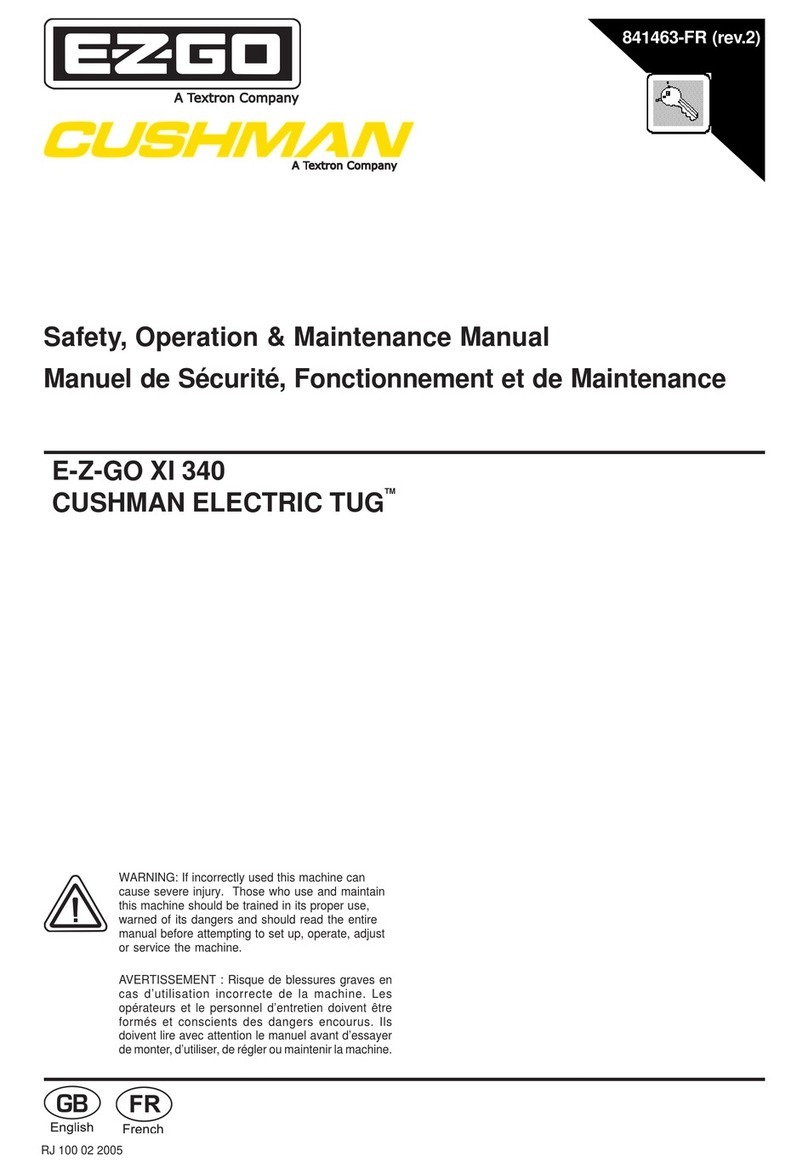
Textron
Textron CUSHMAN ELECTRIC TUG E-Z-GO XI 340 Guide
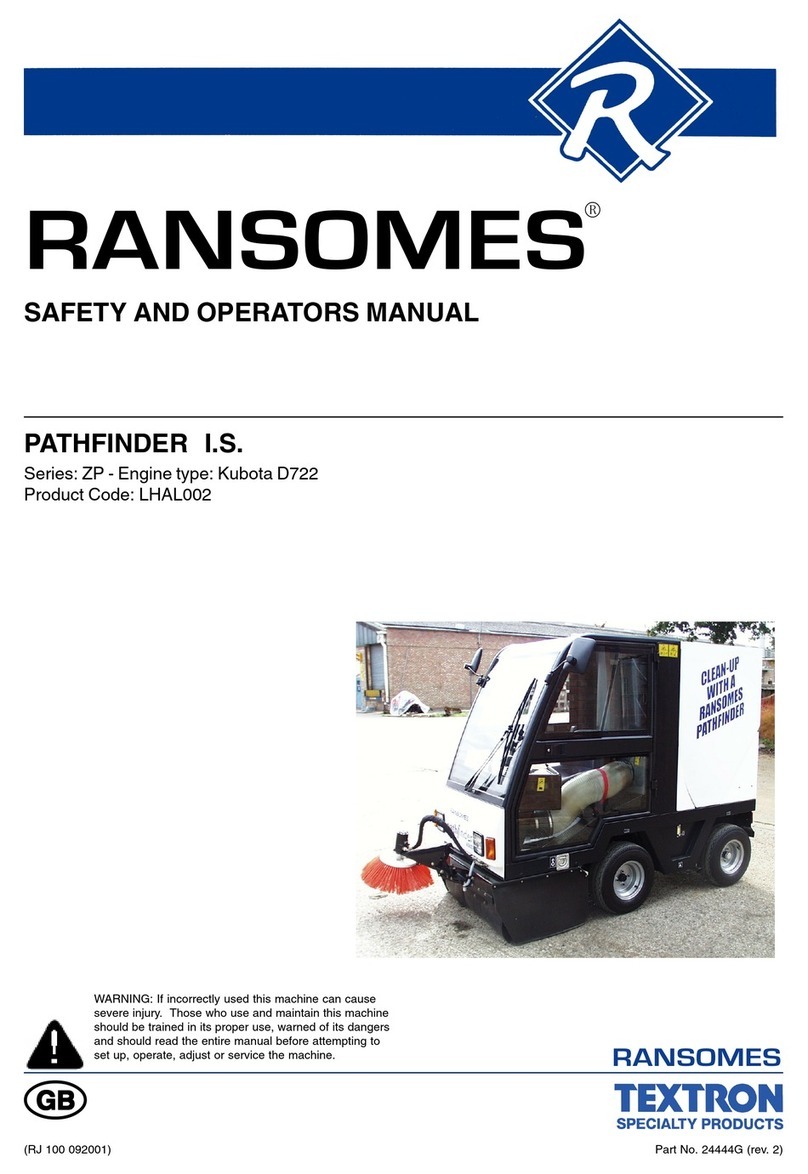
Textron
Textron RANSOMES User manual
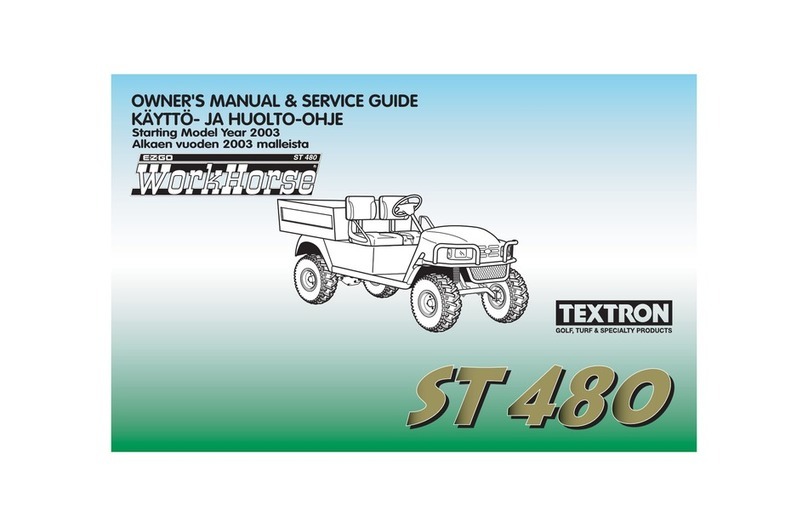
Textron
Textron ST480 User manual
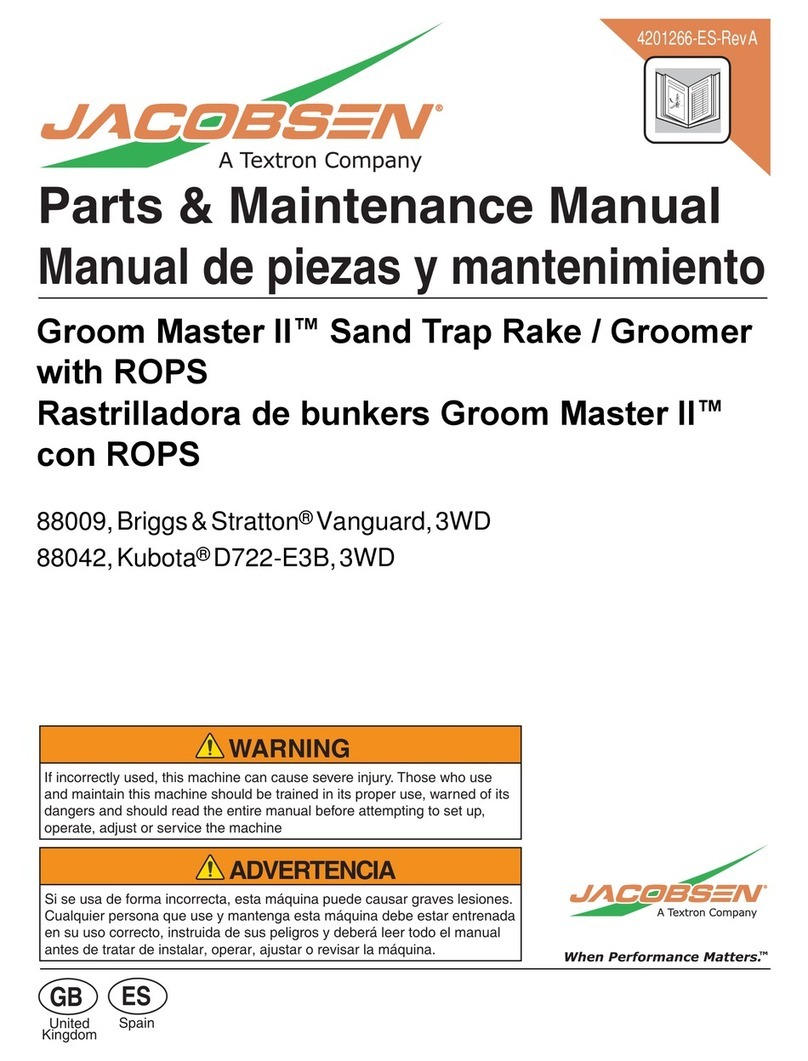
Textron
Textron Jacobsen Groom Master II 88009 User manual
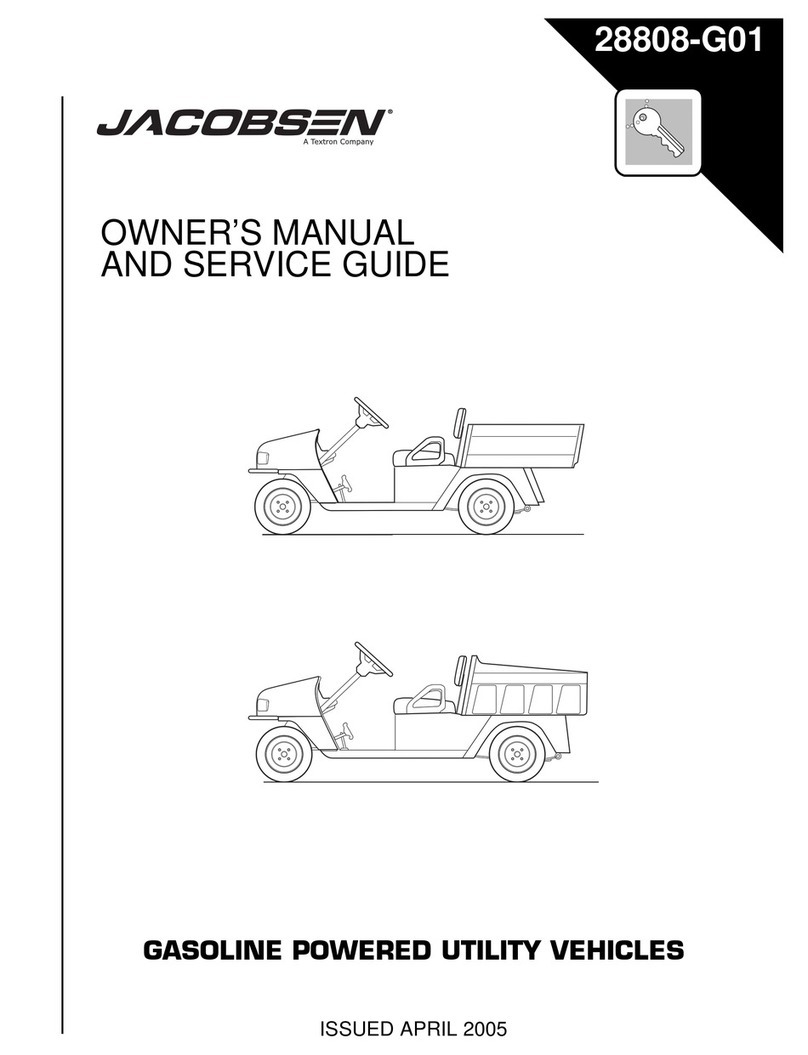
Textron
Textron Jacobsen Hauler 800 2004 User manual
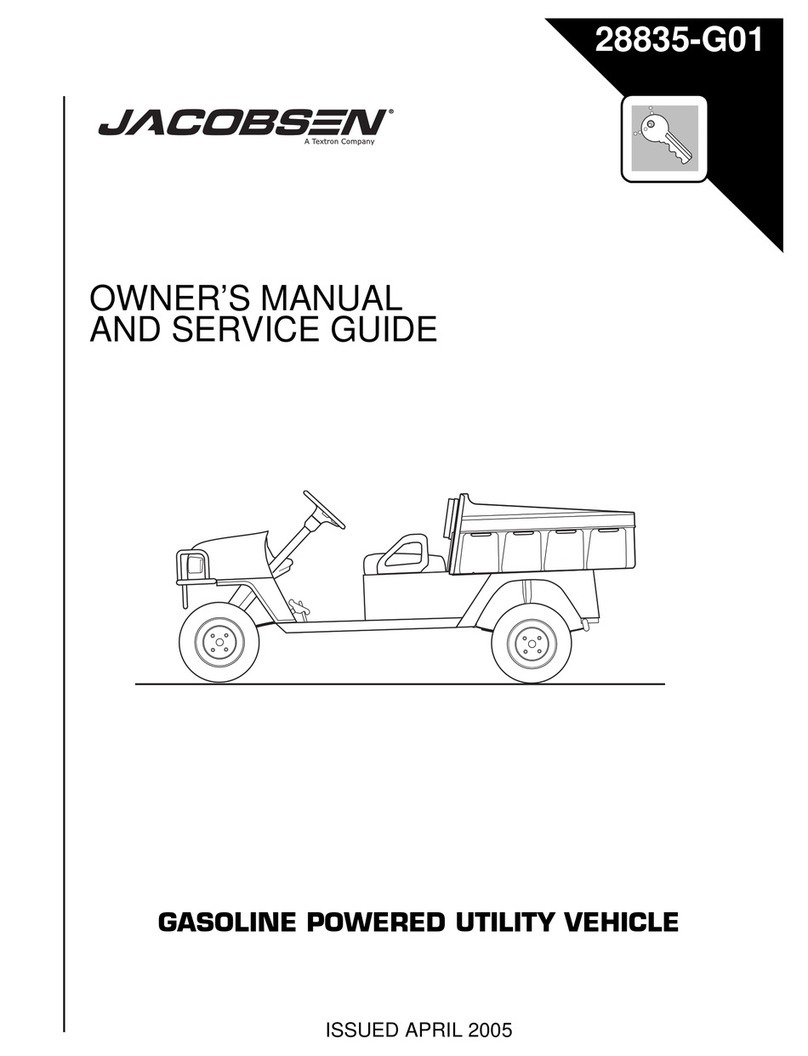
Textron
Textron Jacobsen 3500 User manual

Textron
Textron Ezgo 628442-G User manual
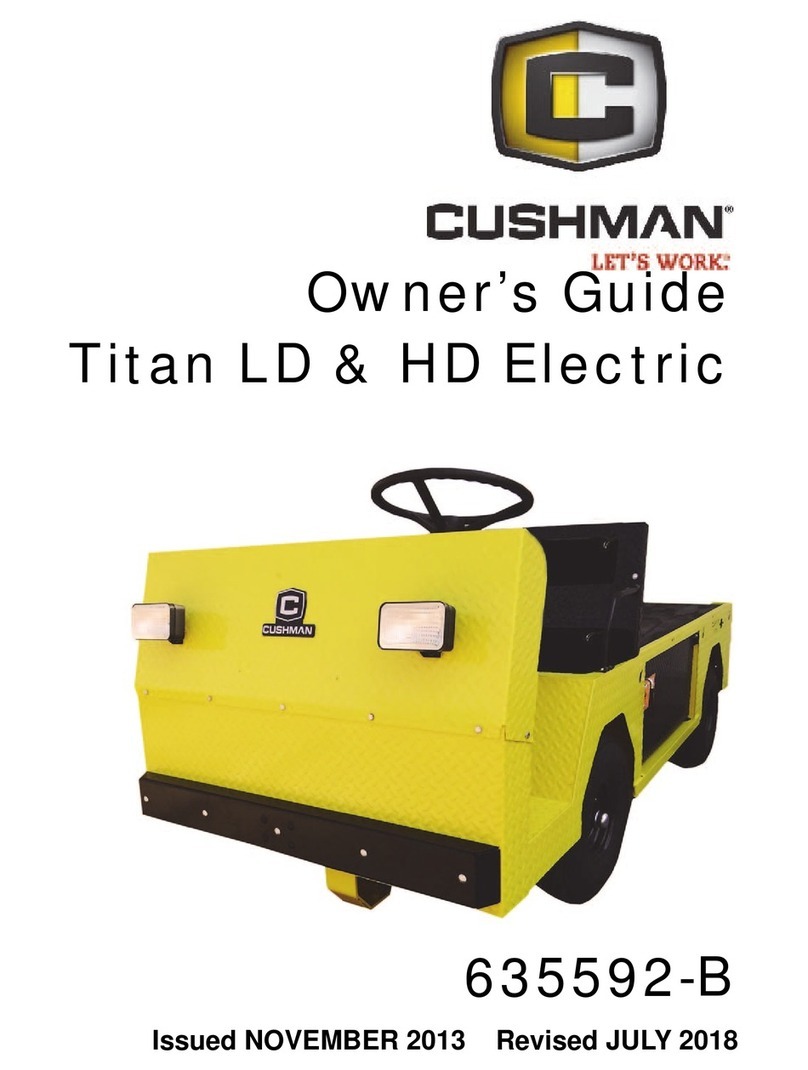
Textron
Textron E-Z-GO Cushman TITAN LD 2014 User manual

